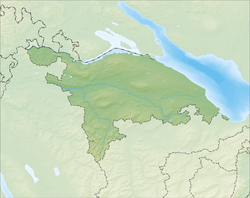Birwinken
| Birwinken | ||
|---|---|---|
 |
||
|
||
| Coordinates: 47°35′N 9°12′E / 47.583°N 9.200°ECoordinates: 47°35′N 9°12′E / 47.583°N 9.200°E | ||
| Country | Switzerland | |
| Canton | Thurgau | |
| District | Weinfelden | |
| Area | ||
| • Total | 12.35 km2 (4.77 sq mi) | |
| Elevation | 550 m (1,800 ft) | |
| Population (Dec 2015) | ||
| • Total | 1,363 | |
| • Density | 110/km2 (290/sq mi) | |
| Postal code | 8585 | |
| SFOS number | 4901 | |
| Localities | Klarsreuti, Andwil, Mattwil, Happerswil-Buch, Birwinken | |
| Surrounded by | Berg, Bürglen, Erlen, Langrickenbach, Lengwil, Sulgen | |
| Website |
www SFSO statistics |
|
Birwinken is a municipality in the district of Weinfelden in the canton of Thurgau in Switzerland.
Birwinken is probably first mentioned in 822 as Wirinchova. In 1275 it was mentioned as Birbichon.
In the 14th Century, Birwinken and Dotnacht formed a distant part of the Herrschaft of Spiegelberg near Weingarten. Due to its location away from the rest of the Herrschaft it was sold to a number of other owners, before it was sold by the Muntprat family of Constance, in 1640, to the city of Zurich. The low court of Birrwinken became part of the property of the Vogt of Weinfelden in 1649. Through the court, the village remained tied to Weinfelden until 1798. Between 1803 and 1816 it was a district capital.
The village church is mentioned no later than the 12th Century. By 1400, the parish was under the Augustinian monastery in Constance, and until the Protestant Reformation in 1529, was overseen by a monk. The church became a Reformed parish which included the village of Andwil. The parish remained independent until 1578, when it became a filial church of Langrickenbach. The Catholics in the village belonged to the parish of Berg after 1869.
In the 19th Century the village economy add animal husbandry to the traditional agriculture and fruit growing. In 1878 a weaving and three embroidery factories provided 165 jobs. However, the decline of the textile industry in the 20th Century and village's remoteness led to high levels of emigration. Due to the emigration, the village never developed much industry and has remained a mostly agricultural village. In 1990, 63% of the population worked in agriculture.
...
Wikipedia




